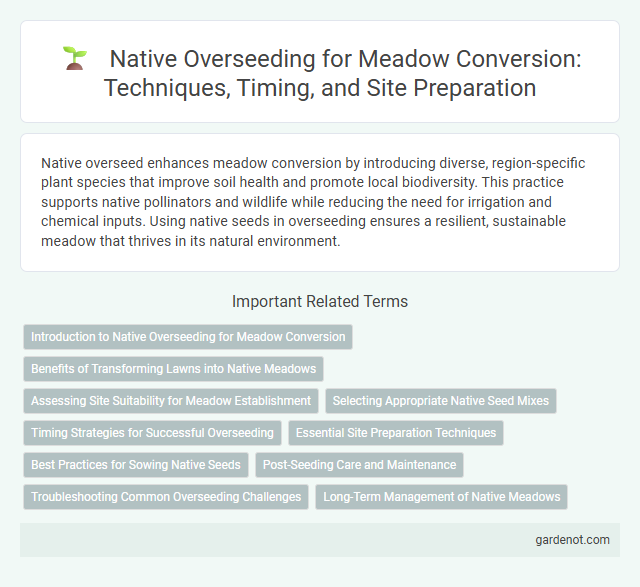Native overseed enhances meadow conversion by introducing diverse, region-specific plant species that improve soil health and promote local biodiversity. This practice supports native pollinators and wildlife while reducing the need for irrigation and chemical inputs. Using native seeds in overseeding ensures a resilient, sustainable meadow that thrives in its natural environment.
Introduction to Native Overseeding for Meadow Conversion
Native overseeding enhances meadow conversion by introducing diverse, region-specific grass and wildflower species that improve soil health and biodiversity. This method promotes resilient, low-maintenance meadows adapted to local climate conditions, reducing the need for irrigation and fertilizers. Emphasizing native overseeding supports pollinator habitats and strengthens ecosystem services within converted meadow landscapes.
Benefits of Transforming Lawns into Native Meadows
Transforming traditional lawns into native meadows with native overseed enhances biodiversity by supporting local pollinators and wildlife. Native overseed varieties are adapted to regional climates, reducing water consumption and maintenance efforts. This eco-friendly conversion improves soil health and promotes sustainable landscaping practices.
Assessing Site Suitability for Meadow Establishment
Assessing site suitability for native overseed in meadow conversion involves evaluating soil fertility, moisture levels, and existing vegetation to ensure optimal seed germination and growth. Understanding local climate patterns and native plant adaptability enhances the success rate of establishing a resilient meadow ecosystem. Soil pH and compaction are critical factors influencing the selection of appropriate native species for overseeding.
Selecting Appropriate Native Seed Mixes
Selecting appropriate native seed mixes for meadow conversion ensures optimal soil adaptation, biodiversity enhancement, and long-term sustainability. Focus on regional species that support local pollinators and wildlife while matching soil type, moisture levels, and sun exposure. Tailored seed mixes increase establishment success and create resilient, self-sustaining native meadows.
Timing Strategies for Successful Overseeding
Optimal timing for native overseed involves early fall when soil temperatures range between 50degF and 65degF, promoting seed germination and establishment before winter dormancy. Applying overseed during recent rains ensures adequate moisture, which is critical for seed-to-soil contact and enhances germination rates. Avoiding late overseeding reduces competition with established meadow species and protects delicate seedlings from harsh winter conditions.
Essential Site Preparation Techniques
Essential site preparation techniques for native overseed in meadow conversion include thorough soil assessment to determine pH and nutrient levels, ensuring optimal seed-to-soil contact by removing existing vegetation and loosening soil, and implementing proper drainage to prevent waterlogging. Incorporating organic matter such as compost enhances soil structure and fertility, promoting vigorous seed germination. Precision in seed bed preparation maximizes the establishment of native species, supporting biodiversity and ecosystem resilience.
Best Practices for Sowing Native Seeds
For effective meadow conversion using native overseed, select region-specific native seed varieties to enhance biodiversity and ecosystem resilience. Prepare the soil by removing invasive species and lightly tilling to create optimal seed-to-soil contact, ensuring proper moisture levels are maintained during germination. Sow seeds at the recommended rate and timing for local climate conditions, followed by gentle irrigation to support early establishment without causing soil erosion.
Post-Seeding Care and Maintenance
Native overseed requires consistent moisture retention through regular watering to ensure seed germination and root establishment. Avoid excessive foot traffic on the newly seeded area to prevent soil compaction and damage to emerging seedlings. Fertilize with a balanced, slow-release organic fertilizer to promote healthy growth and enhance soil nutrient levels during the early stages of meadow conversion.
Troubleshooting Common Overseeding Challenges
Native overseed often faces challenges such as poor seed-to-soil contact, inconsistent moisture levels, and weed competition. To improve germination rates, ensure the soil is well-prepared by lightly raking and maintaining consistent irrigation schedules. Implementing these practices enhances seed establishment and promotes a healthy, diverse meadow conversion.
Long-Term Management of Native Meadows
Native overseed enhances biodiversity and soil health, promoting resilient native meadows through sustained plant diversity. Effective long-term management includes periodic monitoring, selective mowing, and adaptive watering schedules to support native species growth and suppress invasive plants. Integrating native overseed practices ensures meadow ecosystems flourish, maintaining ecological balance and habitat value over time.
Native overseed Infographic

 gardenot.com
gardenot.com